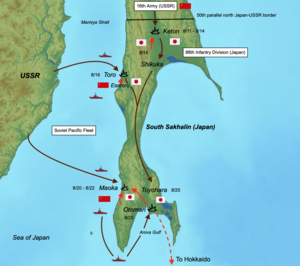You can help expand this article with text translated from the corresponding article in Japanese. (October 2016) Click [show] for important translation instructions.
|
This article needs additional citations for verification. (December 2015) |
| Soviet invasion of South Sakhalin | |||||||||
|---|---|---|---|---|---|---|---|---|---|
| Part of the Soviet–Japanese War | |||||||||
 Map of the Invasion of South Sakhalin | |||||||||
| |||||||||
| Belligerents | |||||||||
|
|
| ||||||||
| Commanders and leaders | |||||||||
|
|
| ||||||||
| Units involved | |||||||||
|
|
| ||||||||
| Strength | |||||||||
| 100,000 men | 19,000 men (excluding 10,000 reservists) | ||||||||
| Casualties and losses | |||||||||
|
56th Rifle Corps: 527+ killed 845+ wounded[1] Pacific Fleet: 89+ killed Total killed: 616–1,191+ killed[2] |
Northern Army: 700–2,000 killed 18,202 captured | ||||||||
| 3,500–3,700 Japanese civilian casualties | |||||||||
The Soviet invasion of South Sakhalin, also known as the Battle of Sakhalin (Russian: Южно-Сахалинская операция, romanized: Yuzhno-Sakhalinskaya operatsiya; Japanese: 樺太の戦い, romanized: Karafuto no tatakai), was the Soviet invasion of the Japanese portion of Sakhalin Island known as Karafuto Prefecture. The invasion was part of the Soviet–Japanese War,[3] a minor campaign in the Asian Theatre during Second World War.
- ^ "Курильская операция – Моя родина – Магадан". www.kolymastory.ru. Retrieved 6 April 2018.
- ^ Our Kuriles and Japanese Claims p. 22, retrieved 6 April 2018
- ^ Ealey, Mark (26 February 2006). "As World War II entered its final stages the belligerent powers committed one heinous act after another". History News Network. Retrieved 24 December 2015.